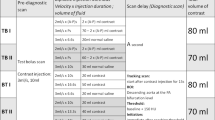Summary
Through the introduction of newly invented high-performance gradient systems to MRI, which enable for echoplanar imaging (EPI), also magnetic resonance angiography (MRA) has gained an entirely new field of applications and techniques. Ultrafast imaging techniques in MRA allow the investigation of larger vascular areas within a single breathhold-period. Artifacts like motion induced signal misregistrations, dephasing or saturation of the vascular signal are minimized by extremely short echo times.
The technique thus requires the intravenous application of a contrast media bolus, usually a gadolinium compound, which is in standard clinical use. Coordination of the bolus injection and the timing of the data acquisition is crucial for optimal results. The first pass evaluation of the contrast media resembles CTA to a certain extend.
Due to the fast measurement and the high contrast in contrast-enhanced MRA (CE-MRA) new applications and indications are developed like MRA of the pulmonary vessels. The paper offers considerations and trials for optimization of thoracical CE-MRA. Besides parameter constellation also bolus-optimization is described with respect to the dedicated anatomical premises. Investigations on volunteers and on patients build a basis for suggestions on optimized CE-MRA procedures.
To date, a final estimation of the clinical value of the new technique cannot be given since ongoing improvements change the optimal protocol frequently and the potential of further developments is high.
Zusammenfassung
Mit der Einführung schneller Gradientensysteme, die eine echoplanare Bildgebung (EPI) erlauben, wurden auch in der Magnetresonanzangiographie (MRA) neuartige Techniken möglich, die jetzt durch ultraschnelle Meßzeiten große Gefäßregionen in einem einzigen Atemstillstandszyklus untersuchen. Hierdurch lassen sich die bewegungsinduzierten Bildunschärfen reduzieren oder aufheben, darüber hinaus sind auch physikalische Störphänomene wie Signalsättigung oder Dephasierung durch die extrem kurzen Echozeiten minimalisiert. Die bei der kurzen Akquisition insgesamt reduzierte Signalausbeute wird in der vorgestellten Technik durch die Applikation eines intravenös verabreichten Gadoliniumpräparates aufgehoben. Die Koordination des Meßvorganges mit der ersten Passage des Kontrastmittels („first pass“) durch die Untersuchungsregion ist analog zu einer Computertomographieangiographie (CTA) essentiell. Die Kontrastmittel-MRA (KM-MRA) eröffnet durch die Geschwindigkeit und den hohen Kontrast neue Indikationsbereiche: so werden erstmals diagnostisch verwertbare Angiogramme der pulmonalen Gefäßstrombahn möglich. In der vorliegenden Arbeit werden Berechnung und Versuche zur Optimierung der KM-MRA der thorakalen Gefäße vorgestellt. Vorschläge zur Parameterkonstellation der MRA-Sequenz und zur Optimierung der Kontrastmittelapplikation werden anhand von Probandenmessungen erarbeitet und physikalisch erläutert.
Die KM-MRA der pulmonalen Strombahn wird als Single-dose-Technik in einem Zeitrahmen von ca. 30 s empfohlen. Erste Erfahrungen an Patienten und Korrelationen zu alternativen Untersuchungstechniken werden angeboten. Bei dem noch frühen Entwicklungsstand der Technik kann noch keine letztliche Einschätzung der klinischen Relevanz gegeben werden.
Similar content being viewed by others
Author information
Authors and Affiliations
Rights and permissions
About this article
Cite this article
Bongartz, G., Boos, M., Winter, K. et al. MR angiography of the thoracic vessels. Radiologe 37, 529–538 (1997). https://doi.org/10.1007/s001170050250
Issue Date:
DOI: https://doi.org/10.1007/s001170050250




